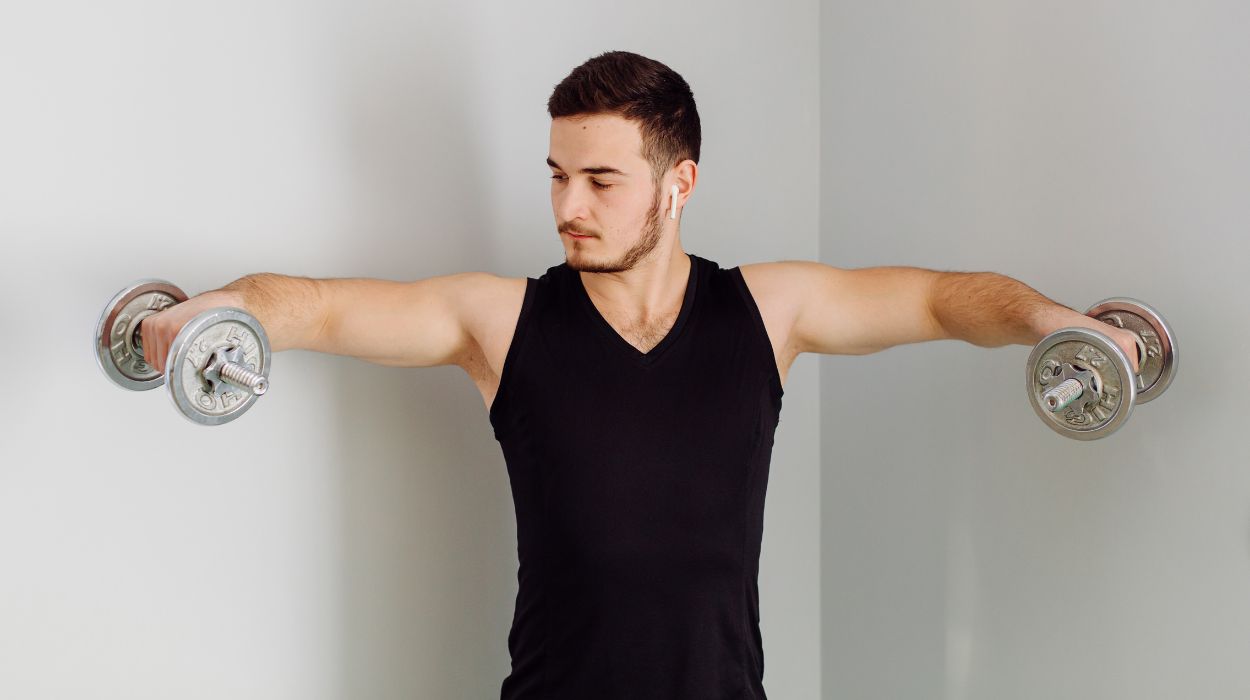
Interested in building a strong pair of boulder shoulders and a more aesthetically pleasing physique? Or perhaps you just want to improve shoulder stability and mobility? Whatever the case may be, look no further. Here we will cover seven of the best dumbbell shoulder exercises.
In addition to the best workouts, we will cover the four main benefits of shoulder dumbbell exercises and the two most impactful tips for your shoulder workouts with dumbbells. With what we cover here, you will be ready to transform your workouts and gain the shoulders you’ve always wanted.
Dumbbell Shoulder Workouts
Amazing shoulders don’t build themselves, but with so many workouts out there, it can be hard to know which ones are the best. With that in mind, we have taken the guesswork out for you and have narrowed it down to the following seven exercises:
- Seated Dumbbell Shoulder Press.
- Dumbbell Arnold Press.
- Dumbbell Lateral Raise.
- Dumbbell Reverse Fly.
- Dumbbell Upright Row.
- Standing Dumbbell Press.
- Standing Single Arm Dumbbell Press (Semi-Pronated Grip).
These exercises can increase shoulder muscle strength and hypertrophy as well as improve aesthetics, shoulder stability with reduced injury risk, and improved shoulder joint mobility.
7 Best Dumbbell Shoulder Exercises
Various factors play into making a great dumbbell shoulder workout. Below, we will cover each dumbbell shoulder workout individually with a walkthrough of the technique and the benefits of each exercise.
Seated Dumbbell Shoulder Press
The seated shoulder press with dumbbells is one of the most frequently used dumbbell exercises for the shoulder. Not only is it simple, but its primary focus is on all three parts of the shoulder (front, middle, and rear) and secondarily works the triceps. Over the long term, this exercise may provide some good results when it comes to building muscle and strength in the arms and shoulders.
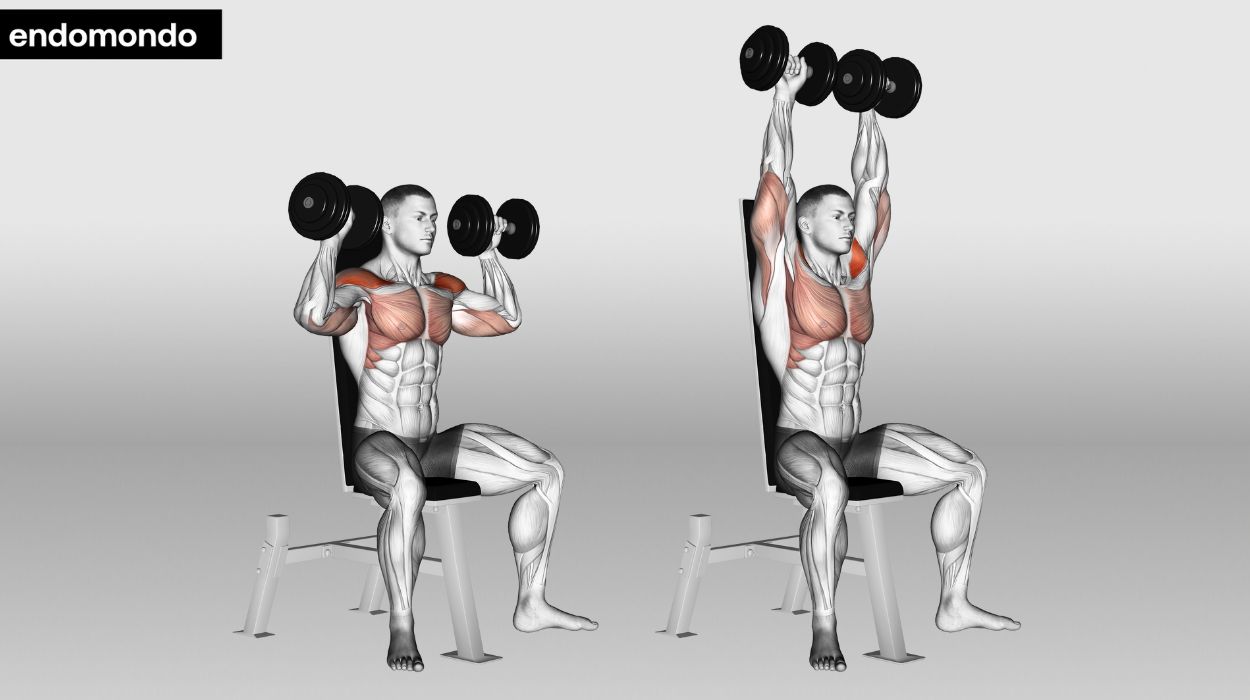
How to do:
- Sit on a bench with back support, holding a dumbbell in each hand at shoulder height, palms facing forward.
- Press the dumbbells upwards until your arms are fully extended overhead, but not locked out.
- Lower the dumbbells back down to shoulder height with control, maintaining a slight bend in your elbows.
- Repeat for the desired number of repetitions, focusing on maintaining proper form and control throughout the movement.
Tips:
- Sit with a straight back and engaged core to maintain stability throughout the movement.
- Keep your elbows slightly forward and wrists in line with your elbows to reduce stress on the wrists.
- Press the dumbbells directly overhead, avoiding excessive arching of the lower back or leaning backward.
Optimal Sets and Reps: 3 sets of 8-12 reps.
Dumbbell Arnold Press
The Arnold Press took the limelight of the bodybuilding/fitness world in the 1970s. It was made famous by the legendary bodybuilder and seven-time Mr Olympia Arnold Schwarzenegger.
The Arnold press shares some similarities to the seated dumbbell press, in that you are seated upright on a bench. The difference, however, is that the Arnold press starts with the palms facing inwards and close to the center of the chest, with the elbows facing forwards/ upper tucked into the body.
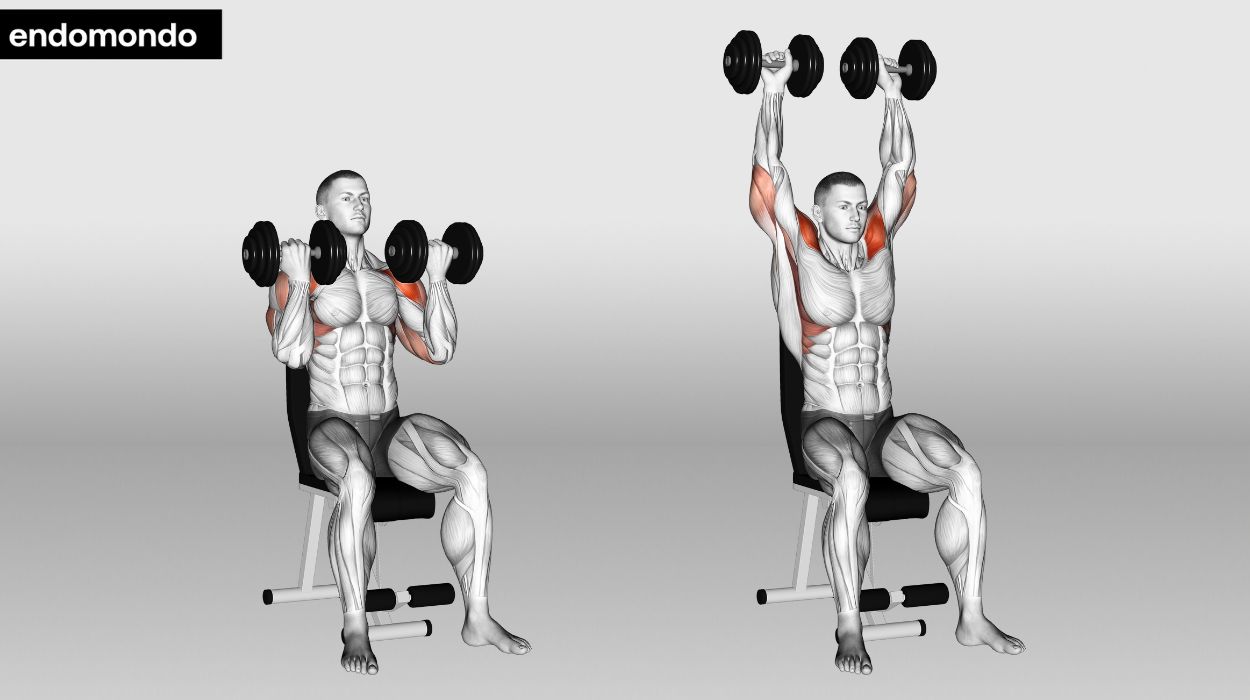
How to do:
- Start by sitting on a bench with back support, holding a dumbbell in each hand at shoulder height with your palms facing towards you and your elbows bent.
- Press the dumbbells upwards while simultaneously rotating your palms to face forward until your arms are fully extended overhead.
- Slowly lower the dumbbells back down to shoulder height while rotating your palms back to the starting position.
- Repeat for the desired number of repetitions, focusing on maintaining proper form and control throughout the movement.
Tips:
- Begin with a neutral spine and engaged core to maintain stability throughout the movement.
- Rotate your palms as you press the dumbbells overhead, engaging multiple shoulder muscles for a complete shoulder workout.
- Control the descent of the dumbbells as you bring them back to the starting position, focusing on eccentric muscle contraction.
Optimal Sets and Reps: 3 sets of 8-12 reps.
Dumbbell Lateral Raise
The lateral raise is a highly recommended dumbbell shoulder exercise that isolates the middle part of the shoulders. The reason it is considered an isolation exercise is that it does not draw any triceps into activity like most dumbbell pressing movements.
Since this is an isolation exercise, be sure not to start with too much weight.
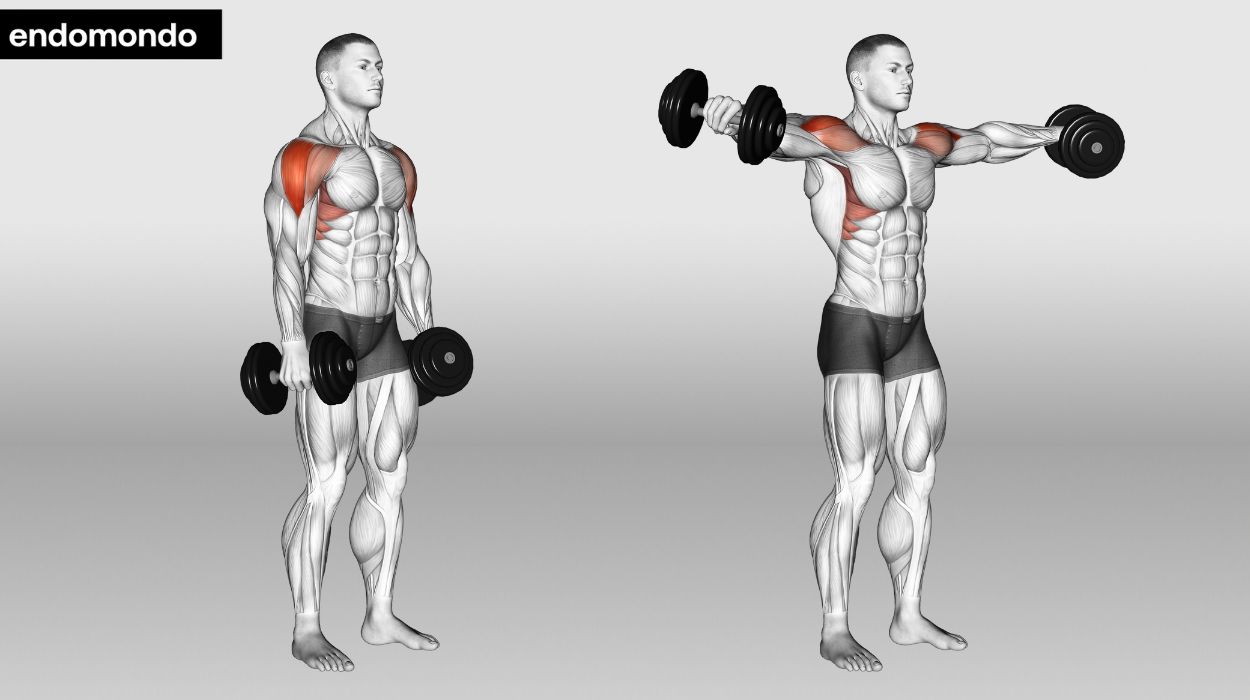
How to do:
- Stand tall with a dumbbell in each hand, palms facing your body, and arms by your sides.
- Keeping a slight bend in your elbows, raise both dumbbells out to the sides until they reach shoulder height.
- Pause briefly at the top of the movement, then slowly lower the dumbbells back down to the starting position.
- Repeat for the desired number of repetitions, focusing on maintaining proper form and control throughout the exercise.
Tips:
- Keep a slight bend in your elbows and avoid swinging your body to lift the weights, focusing on using your shoulder muscles.
- Lift the dumbbells to shoulder height or slightly below, ensuring controlled movement throughout the exercise.
- Engage your core to stabilize your body and prevent arching your back during the movement.
Optimal Sets and Reps: 3 sets of 10-15 reps.
Dumbbell Reverse Fly
The reverse fly is an upper-body exercise with similarities to the lateral raise, but it is performed from a bent-over position. Moving the upper arm out and up with a slight bend in the elbows.
Instead of targeting the middle part of the shoulder, the dumbbell reverse fly works the posterior deltoid/rear part.
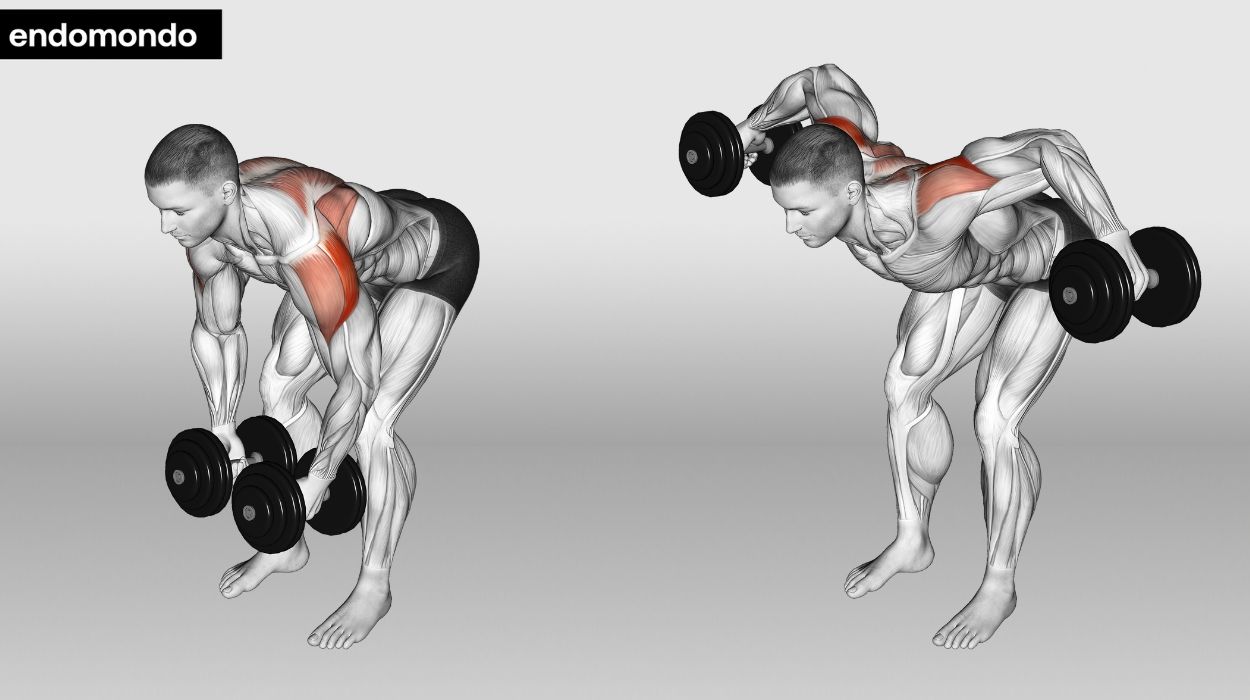
How to do:
- Begin by holding a dumbbell in each hand with a neutral grip, palms facing each other, and stand with your feet hip-width apart.
- Keep your knees slightly bent and hinge forward at your hips while keeping your back straight, maintaining a slight bend in your elbows.
- With control, raise your arms out to the sides until they are parallel to the floor, squeezing your shoulder blades together at the top of the movement.
- Slowly lower the dumbbells back to the starting position and repeat for the desired number of repetitions, focusing on maintaining proper form and control throughout the exercise.
Tips:
- Focus on squeezing your shoulder blades together at the top of the movement to engage the muscles of the upper back effectively.
- Keep a slight bend in your elbows throughout the exercise to reduce strain on the joints.
- Maintain a neutral spine and avoid arching your back as you hinge forward at the hips.
Optimal Sets and Reps: 3 sets of 10-12 reps.
Dumbbell Upright Row
The dumbbell upright row is a bit different from most shoulder exercises with dumbbells as it is a pulling movement that targets the middle part of the shoulder.
To perform this lift, you would pull the dumbbells up in front of your body. The motion is much like the motion of pulling up a pair of pants from the front, but in this case pulling up to the mid or upper chest, depending on your ability.
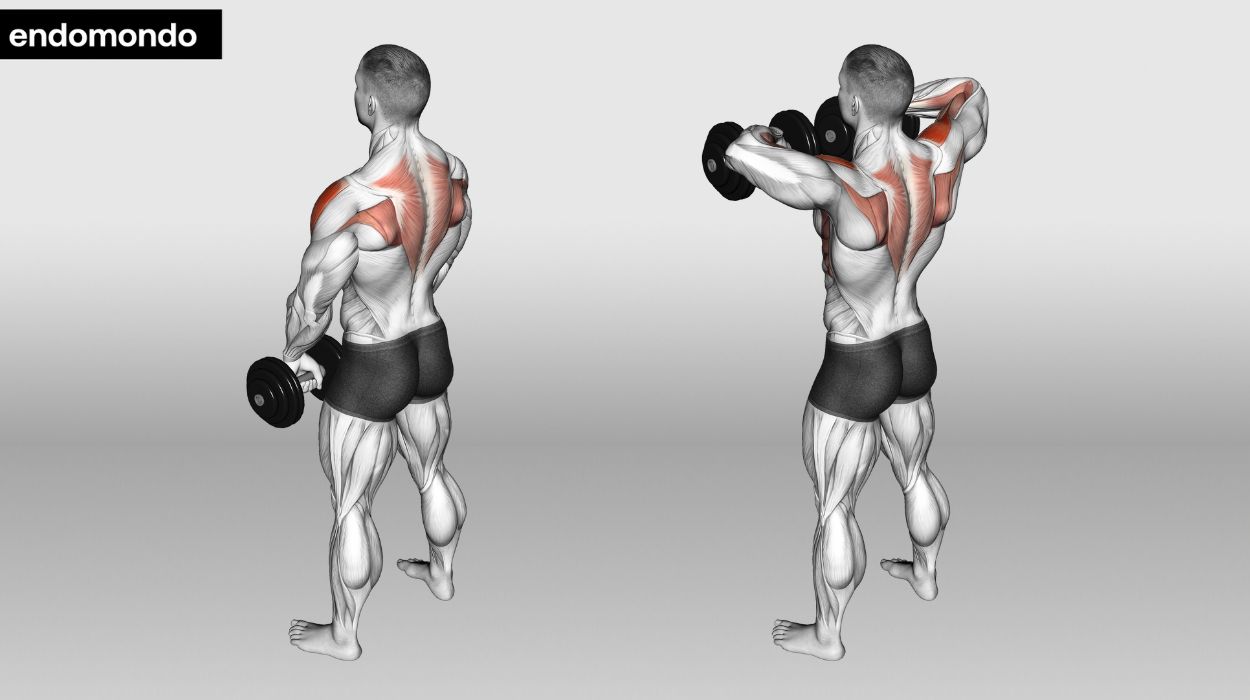
How to do:
- Stand with your feet shoulder-width apart, holding a dumbbell in each hand with an overhand grip, palms facing your body.
- Keep your elbows slightly bent and lift the dumbbells up towards your chin, leading with your elbows.
- As you lift, keep the dumbbells close to your body and your shoulders pulled back, squeezing your shoulder blades together at the top of the movement.
- Lower the dumbbells back down to the starting position with control, maintaining a slow and controlled movement throughout.
Tips:
- Keep your core engaged and maintain a neutral spine throughout the movement to prevent strain on your lower back.
- Focus on lifting the dumbbells with your shoulders, avoiding excessive momentum from your lower body.
- Keep your elbows higher than your wrists as you lift the dumbbells towards your chin, to target the shoulder muscles effectively.
Optimal Sets and Reps: 3 sets of 8-12 reps.
Standing Dumbbell Press
The standing dumbbell press is a brutal compound exercise that activates the core, triceps, upper chest, upper back, and shoulders.
You press a pair of dumbbells from the resting at the shoulders to above the head, arms fully extended. This should be performed standing with the feet shoulder-width apart and a slight bend at the knees to prevent over-extending. Up and down is a single rep.
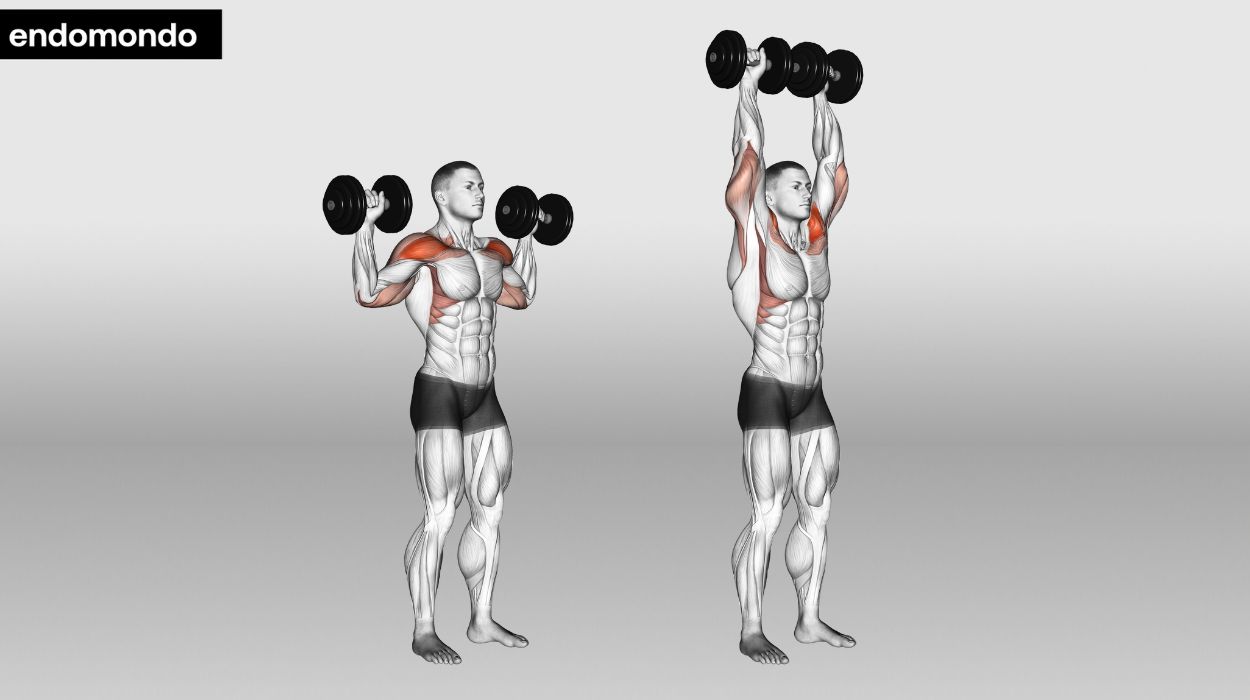
How to do:
- Stand with your feet shoulder-width apart, holding a dumbbell in each hand at shoulder height with your palms facing forward.
- Engage your core and keep your back straight as you press the dumbbells directly overhead.
- Fully extend your arms overhead, but avoid locking out your elbows at the top of the movement.
- Lower the dumbbells back down to shoulder height with control, and repeat for the desired number of repetitions.
Tips:
- Keep your core engaged and maintain a stable stance throughout the movement to support your lower back.
- Focus on pressing the dumbbells directly overhead in a smooth, controlled motion, avoiding any jerking or swinging.
- Exhale as you press the dumbbells overhead and inhale as you lower them back down to shoulder height.
Optimal Sets and Reps: 3 sets of 8-12 reps.
Standing Single Arm Dumbbell Press (Semi-Pronated Grip)
This is the same exercise as the standing dumbbell press, however it is only done with a single arm. Now, while the motion is the same, the imbalance created by having only one weight causes this exercise to engage the core and chest more, potentially giving an even more intense workout. This makes the standing single-arm dumbbell press a great exercise to include in your dumbbell shoulder workouts.
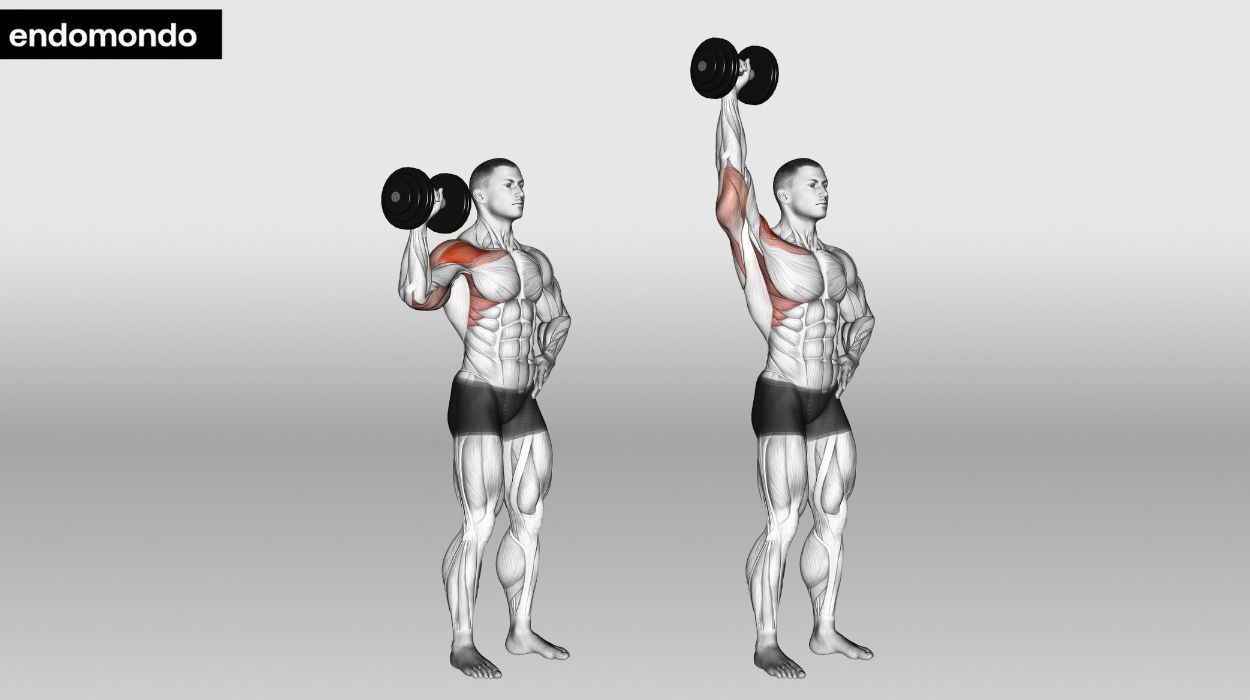
How to do:
- Stand with your feet shoulder-width apart, holding a dumbbell in one hand with a semi-pronated grip, palm facing towards your body, and the other hand on your hip.
- Start with the dumbbell at shoulder height, elbow bent, and forearm perpendicular to the floor.
- Press the dumbbell directly overhead while keeping your core engaged and maintaining a stable stance.
- Fully extend your arm overhead, but avoid locking out your elbow, then lower the dumbbell back down to shoulder height with control.
- Repeat for the desired number of repetitions, then switch sides and repeat with the other arm.
Tips:
- Engage your core and maintain a stable stance throughout the movement to support your lower back.
- Keep your elbow slightly in front of your body and your wrist straight to optimize shoulder mechanics and reduce strain.
- Press the dumbbell directly overhead in a smooth, controlled motion, avoiding any excessive leaning or twisting.
Optimal Sets and Reps: 3 sets of 8-12 reps per arm.
Reasons To Do Dumbbell Shoulder Exercises
As you can see, shoulder exercises with dumbbells provide unique benefits when incorporated into your shoulder workout plan and when performed consistently and correctly. In this section, we will go over some of the main benefits these exercises have to offer.
Increased Shoulder Muscles Strength And Hypertrophy
Dumbbells are great for a variety of upper body exercises, as they can help develop strength and muscle mass at the shoulders.[1] This can be done with a variety of compound and isolation exercises.
Isolation exercises, like shoulder flies, are great for targeting individual muscles for muscle building. On the other hand, heavy compound exercises like the seated dumbbell press train at higher intensities (weights) for lower reps to focus on strength. All of this leads to bigger, stronger shoulders.
Improved Aesthetics
A well-developed pair of shoulders is very aesthetically pleasing. When the shoulders are wider than the waistline, it creates a V-taper shape, a coveted part of a chiseled physique.
Improve Shoulder Stability, Reduce Injury Risk

There are three parts to the shoulder muscle, which include the front, middle, and rear deltoids. Due to an imbalanced focus on the front of the shoulder, some lifters lack muscle mass in the rear deltoids, which causes the shoulder joint to roll forward. Over time, this can cause friction in the shoulder girdle and lead to injury to the joint.
Having a balance of muscle in these areas, however, will allow for the shoulder joint[2] to sit in a natural, centered position. This is why it is so important to include a variety of dumbbell shoulder exercises in your shoulder workout routine, providing well-rounded strength and joint protection at the same time.
Improved Shoulder Joint Mobility
Some individuals lack shoulder mobility to the extent that they can not conduct daily tasks like reaching upwards to put something on a shelf. This can occur for a variety of reasons, but a simple and generally safe solution is to include lightweight shoulder workouts to strengthen these muscles.
Of course, if you have pain when doing any of these motions, seek medical care and guidance before attempting to “push through” and do any form of exercise, as you could worsen your condition or injury.
Tips For Doing Shoulder Dumbbell Exercises
Warm Up
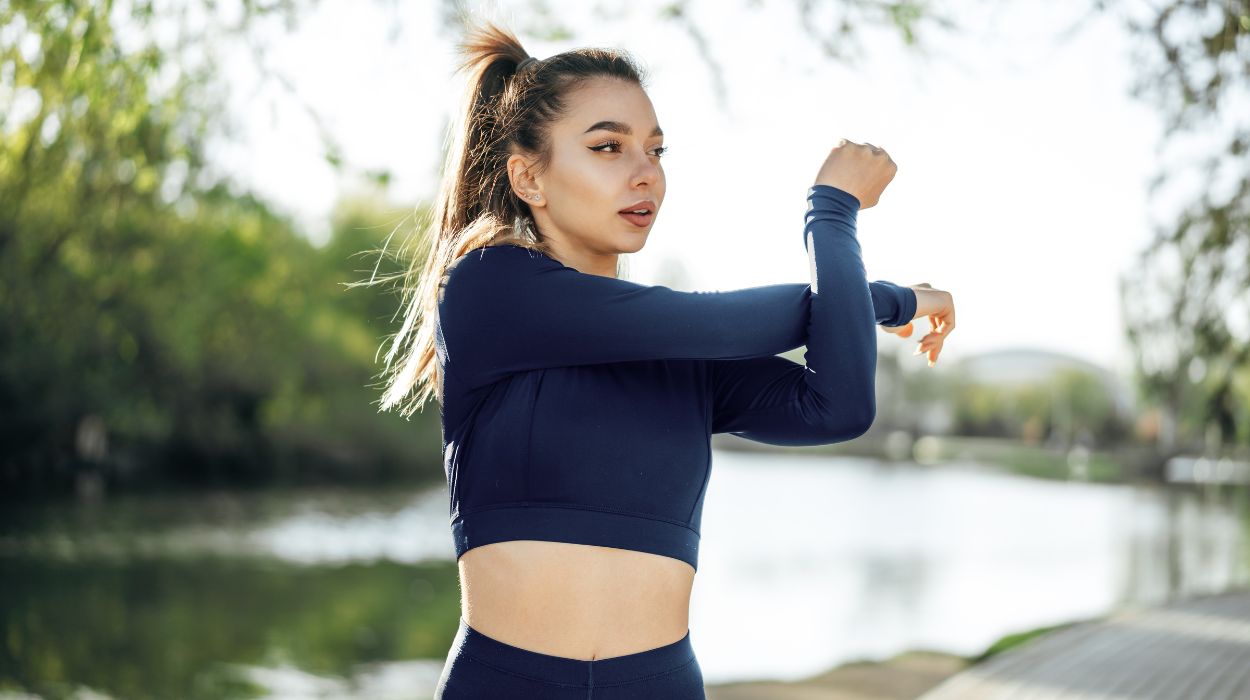
The importance of warming up[3] cannot be overstated. Warming up can increase core body temperature and lubricate the joints with synovial fluid, which makes the joints more mobile and the muscles/tendons more pliable, therefore reducing the risk of injury during shoulder exercises.
Observe Proper Form
It is important to never lift more than you are able! For any shoulder exercise, you should lift a weight that can comfortably be done for approximately five reps to build strength and 8-12 reps for muscle building.
Smart weight selection will allow you to target the shoulder muscles specifically and take the stress off other muscles and joints. For example, if you select a weight that is too heavy, it is easy to use momentum to raise the weight, instead of using the shoulder, cheating your muscles of the benefits and risking injury in the process.
Conclusion
Shoulder exercises are great for building strength and muscle, as well as improving overall aesthetics. They also improve shoulder stability, reduce the risk of shoulder joint injury, and improve mobility for everyday activities.
While any or all of the exercises covered here can provide the benefits above, be sure to warm up and use the proper form to optimize muscle activation and minimize the risk of injury.
Frequently Asked Questions
Once or twice per week should help build the shoulder muscles effectively.
Roughly 3-5 sets for 5-12 reps per set for strength and muscle gains.
To be completely sure you have good mobility to complete these exercises, consult a physical therapist or personal trainer.
Resources
- Yuri, Vianna, J.M., Guimarães, M.P., Jorge, Hernández-Mosqueira, C., Silva and Marchetti, P.H. (2020). Different Shoulder Exercises Affect the Activation of Deltoid Portions in Resistance-Trained Individuals. Journal of Human Kinetics, [online] 75(1), pp.5–14. doi:https://doi.org/10.2478/hukin-2020-0033.
- Goetti, P., Denard, P.J., Collin, P., Ibrahim, M., Hoffmeyer, P. and Alexandre Lädermann (2020). Shoulder biomechanics in normal and selected pathological conditions. EFORT open reviews, [online] 5(8), pp.508–518. doi:https://doi.org/10.1302/2058-5241.5.200006.
- Parisien, R.L., Pontillo, M., Farooqi, A.S., Trofa, D.P. and Sennett, B.J. (2021). Implementation of an Injury Prevention Program in NCAA Division I Athletics Reduces Injury-Related Health Care Costs. Orthopaedic Journal of Sports Medicine, [online] 9(9), p.232596712110298-232596712110298. doi:https://doi.org/10.1177/23259671211029898.




